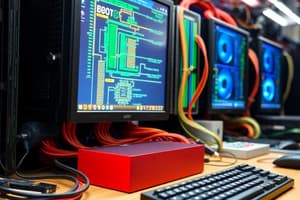Podcast
Questions and Answers
What do processes need to accomplish their tasks?
What do processes need to accomplish their tasks?
- CPU, memory, I/O, and files (correct)
- I/O, files, and initialization data
- Initialization data, CPU, and I/O
- Only CPU and memory
What is the characteristic of a single-threaded process?
What is the characteristic of a single-threaded process?
- It uses multiple CPUs
- It can handle multiple tasks concurrently
- It has multiple program counters
- It executes instructions sequentially (correct)
What is a key feature of multi-threaded processes?
What is a key feature of multi-threaded processes?
- They execute instructions in parallel
- They have a single program counter
- They use multiple CPUs
- They have one program counter per thread (correct)
What is a common technique used to achieve concurrency in systems?
What is a common technique used to achieve concurrency in systems?
What is the responsibility of the operating system regarding process management?
What is the responsibility of the operating system regarding process management?
What is a necessary condition for a program to execute?
What is a necessary condition for a program to execute?
What is a consequence of process termination?
What is a consequence of process termination?
What is an important activity of the operating system regarding process management?
What is an important activity of the operating system regarding process management?
What is a characteristic of a system?
What is a characteristic of a system?
What is required for a program to execute?
What is required for a program to execute?
Flashcards are hidden until you start studying
Study Notes
Operating System Concepts
- An operating system acts as an intermediary between a user and the computer hardware, executing user programs, making problem-solving easier, and using hardware efficiently.
- The operating system's goals include:
- Executing user programs and making problem-solving easier
- Making the computer system convenient to use
- Using the computer hardware efficiently
Computer System Structure
- A computer system can be divided into four components:
- Hardware: provides basic computing resources (CPU, memory, I/O devices)
- Operating System: controls and coordinates the use of hardware among various applications and users
- Application Programs: define the ways in which system resources are used to solve computing problems (word processors, compilers, web browsers, etc.)
- Users: people, machines, or other computers
Operating System Definition
- An operating system is a resource allocator that:
- Manages all resources
- Decides between conflicting requests for efficient and fair resource use
- An operating system is a control program that:
- Controls the execution of programs to prevent errors and improper use of the computer
- There is no universally accepted definition of an operating system, but it can be approximated as "everything a vendor ships when you order an operating system."
Storage Structure
- Main memory is the only large storage media that the CPU can access directly, and is:
- Random access
- Typically volatile
- Secondary storage is an extension of main memory that provides large non-volatile storage capacity
- Hard disks are a type of secondary storage that:
- Use rigid metal or glass platters covered with magnetic recording material
- Are logically divided into tracks, which are subdivided into sectors
- Have a disk controller that determines the logical interaction between the device and the computer
- Solid-state disks are a type of secondary storage that:
- Are faster than hard disks
- Are non-volatile
- Use various technologies
Storage Hierarchy
- Storage systems are organized in a hierarchy based on:
- Speed
- Cost
- Volatility
- Caching is a technique used to copy information into faster storage systems, such as main memory being used as a cache for secondary storage
- Device drivers are used to manage I/O operations for each device controller
Caching
- Caching is an important principle performed at many levels in a computer (in hardware, operating system, and software)
- Information in use is copied from slower to faster storage temporarily
- Faster storage (cache) is checked first to determine if information is there
- Cache management is an important design problem
Process Management
- A process is a program in execution, and is a unit of work within the system
- A process needs resources to accomplish its task, including:
- CPU
- Memory
- I/O
- Files
- Initialization data
- Process termination requires the reclaim of any reusable resources
- A single-threaded process has one program counter specifying the location of the next instruction to execute
- A multi-threaded process has one program counter per thread
Process Management Activities
- The operating system is responsible for the following activities in connection with process management:
- Creating and deleting both user and system processes
- Suspending and resuming processes
- Providing mechanisms for process synchronization
- Providing mechanisms for process communication
- Providing mechanisms for deadlock handling
Studying That Suits You
Use AI to generate personalized quizzes and flashcards to suit your learning preferences.




